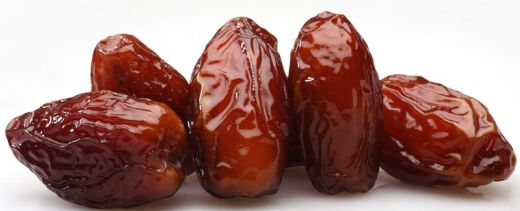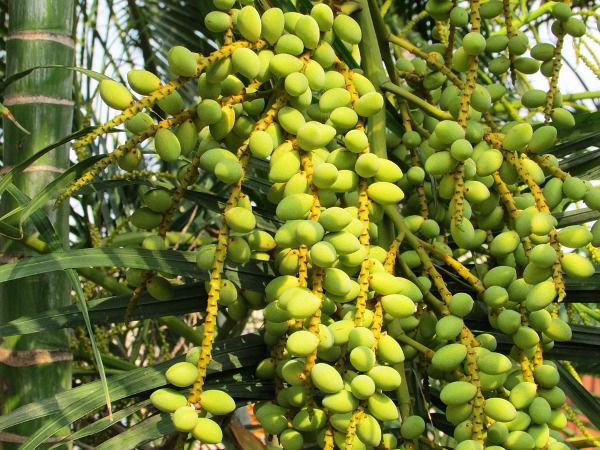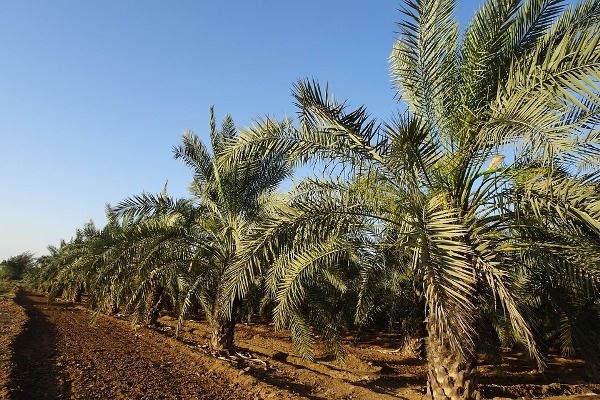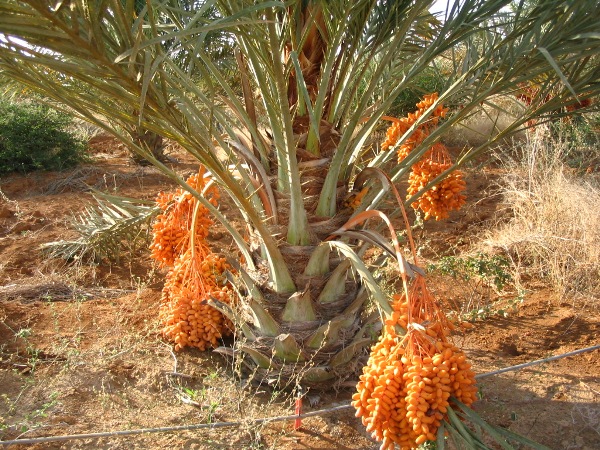Growing Date Palms:
The following content details about growing date palms.
Introduction to Growing Date Palms:- Date palms or Dates are one of the oldest fruit crops cultivated since centuries for its edible fruits. Date fruits have been a staple food of the Middle Eastern region & the Indus Valley for centuries. You can find vast areas of date palms spread across Arabic countries, Africa, Morocco and Israel. Currently, date palms are being grown in most parts of the world. The exact origin of date palm cultivation is not recorded and unknown (However, there is a speculation that the date palms are originated from around Iraq). Date palms can be grown in both tropical and sub-tropical regions of the world. Commercial cultivation of dates is very much successful as dates have excellent demand in local and export markets. Apart from edible part, Date seeds may also used as animal feed (soaked and ground up). Date oils are used in cosmetic industries.
When it comes to description of date trees, they grow about 70 feet in height, growing singly or several stems from single root system. usually, date tree leaves are about 15 to 20 feet long with spines on the petiole and pinnate with about 120 to 15 leaflets. The date tree leaflets are about 25 to 30 cm long and to 2.5 cm wide. The crown (full span) of date tree ranges from 20 to 30 feet.
When it comes to date fruit description, they are oval-cylindrical with 3 to 6 cm length, and 2 to 3 cm diameter. These dates contain single seed (stone) about 2 cm long and 7mm thick. Dates can exists from bright red to bright yellow in colour based on cultivar (variety).
Usually, there are 4 stages of dates ripening.
- Unripe.
- full-size, crunchy.
- ripe, soft.
- ripe, sun-dried.
Scientific Name / Botanical Name of Date Plams:- Phoenix dactylifera.
Family Name of Date Palms:- Arecaceae.
Genus of Date Palms:- Phoenix.
Common Names of Date Palms or Other Country Names:-
- Afrikaans – Dadels.
- Dutch – Dadelpalm.
- German – Datteln.
- Polish – data owoce.
- Scottish – deit.
- Somali – Timir.
- Urdu – khajoor.
- Albanian – Datat.
- Greek – Χουρμάδες.
- Nepali – Khajoor.
- Portuguese – tâmara.
- Spanish – Palma datilera.
- Arabic – بلح .
- Italian – Palma da datteri.
- Norwegian – datoer.
- Thai – วันที่.
- Burmese – son palon.
- Finnish – taateli.
- Hebrew – תָּמָר.
- Japanese – 日付フルーツ / Dates.
- Latvian – Datumi.
- Romanian – curmale.
- Sinhalese – Rata Indi.
- Swahili – Tende.
- French – Palmier-dattier.
- Macedonian – ovošJe datumi.
- Swedish – dadel.
- Turkish – Hurma.
- Danish – Dadler.
- Persian – خرما.
- Sanskrit – बदरं.
Date Palms in Indian Languages: – The following are local names of Dates in India.
- English – Dates.
- Hindi – Khajur.
- Telugu – Kharjoora / Kharjoora Pandu.
- Tamil- Perichampazham.
- Malayalam – Eenthapazham / Eethapazham.
- Bengali – Khejoor.
- Gujarati – Khajur / khajoor.
- Kannada – Kharjoora / Eachalu.
- Konkani – Khajjoor / Kaajjuru.
- Marathi – Khajur / Kharik.
- Assamese – খেজুৰ / Khezur.
- Bhojpuri – Khajoor.
- Kashmiri – Khazer.
- Oriya – Khajura / Khajuri.
World Top 10 Countries of Growing Date Palms:- The following countries are top 10 producers of dates.
- Egypt.
- Saudi Arabia .
- Iran
- United Arab Emirates (UAE).
- Algeria.
- Iraq.
- Pakistan.
- Oman.
- Tunisia.
- Libya.
Health Benefits of Date Palms:- Some of the health benefits of Dates are as follows.

- Dates may lowers cholesterol levels.
- Dates rich source of proteins.
- Dates rich in vitamin like B1, B2, B3 and B5, A1 and C.
- Dates helps in strengthening the nervous system.
- Dates may promote digestion.
- Dates are good for skin health.
Varieties / Types (Cultivars) of Date Palms:- The following are some of the common Date Palms types grown. Some of the Arabian date types are given below.
- Afandi.
- Anbarah.
- Sariyyah.
- Shalaby.
- Gharr.
- Barny.
- Sufry.
- Shahel.
- Lubanah.
- Medjool.
- Menaify.
- Ḥelya.
- Berḥi.
- Rabiyyah.
- Lunah.
- Ḥelwah.
- Khalas.
Climate Requirement for Growing Date Palms:- Dates crop requires long summers with long days, high temperatures and mild winters without frost for ideal growth, flowering and fruiting. During flowering and fruit set stage, it does not prefer any rain but low humid conditions and plenty of sunshine.

Soil Requirement for Growing Date Palms:- Date palms can be grown on wide variety of soils. However, this dates crop require well-drained deep sandy loam soils with good aeration having a pH value of 8.0 to 11. The growing soil should have good moisture holding / retaining capacity. It also requires the soil is free from calcium carbonate. When it comes to soil salinity, these trees can tolerate up to 4dsm-l.
Propagation for Growing Date Palms:- Date palms can be propagated by seeds, offshoots and tissue culture. Germination success depends largely on the growing medium and viable dates seeds may germinate from 2 weeks to 3 weeks after sowing under ideal conditions. Commercial Growers prefer offshoot propagation as a better choice when compared to seed propagation. With seed germination, both male and female palms results in seedlings and this can be recognisable only at the time of flowering stage. Apart from this, seed germination will result in many variations in flowering and fruit qualities.
Land Preparation, Planting and Spacing for Growing Date Palms:- Land should be prepared well enough to remove any old trees, branches and stones from the field. Dig the plant size of 60 cm x 60 cm x 60 cm. Plant to plant distance should be maintained as 6 meter x 6 meter. Bio composting such as cow dung (farm yard manure/organic compost (from earthworms) or sheep manure (dry) should be used.
Irrigation for Growing Date Palms:- Though they are kind of desert trees, timely and uniform irrigation should be provided for better fruiting.

- Provide 30 to 35 litres/tree up to 1 year with the help of drip irrigation.
- Provide 50 to 55 litres/tree/fortnight (2 weeks) for next 2 years with the help of drip irrigation.
- Provide 100 to 110 litres/tree/month for subsequent 2 years with the help of drip irrigation.
- Once trees attain 5 to 6 years old of age, you can convert the watering method from drip irrigation to basin irrigation.
- As a thumb rule, grown up date palm or adult trees require irrigation for every 2 weeks during winter and every week in summer.
Intercultural Operations in Growing Date Palms:-
- Pruning in Growing Date Palms: The pruning process involves of removing diseased and old leaves, dried leaves, spines, cutting of undesirable inflorescences and thinning of fruits. Usually, the number of leaves on the palm tree determines the number of retained inflorescences. An insufficient number of leaves on the palm tree affects the dates quality and reduces the yield of the fruits.
- Fruit Thinning Growing Date Palms: To improve fruit quality, one should carry out fruit thinning. There are 3 ways of fruit thinning.
- Should cut the strands to reduce their length.
- Should remove some strands from the center of the bunch.
- Should reducing the number of fruits on each strand.
- Pollination Growing Date Palms: In date palms growing, hand pollination is recommended because individual date palm tree are either males or females. The general method of pollination is to place strands of male flowers ready to shower pollen grains on the stigmas of the carpels of the female flowers. Finding the time when the female flower is open and ready to receiving pollen is dependent on individual skills. Generally 4 to 5 male date palm plants are sufficient to pollinate 100 date palm female plants.
Manures and Fertilizers for Growing Date Palms:- Apply bio-fertilizers as mentioned in the planting section. The average world wide application of N:P:K in date palm orchards.
| Nutrients (NPK) | Palm Tree/Year (in grams) | Application/Ha/Year (in kg) |
| Nitrogen | 650 | 78 |
| Phosphorus | 650 | 78 |
| Potassium | 870 | 104 |
Pests and Diseases in Growing Date Palms:- Date Palms may be attacked by a disease called ‘Bayoud disease’. This disease is mainly caused by the fungus ‘Fusarium oxysporum’. If the crop is attacked with this disease, you can expect less yield. As preventive method, you can select disease resistant varieties. When it comes to pests in date palm growing, the red palm beetle poses a significant threat to date production. you can talk to horticulture professional for control measures of these diseases and pests.
Note: Your local department of horticulture is a good source of finding information about pests and diseases in growing Date Palms. Don’t experiment on your own without knowing the symptoms and causes.

Harvesting in Growing Date Palms:- First harvesting may be carried out after 4 years. Because of the fact that all the fruits ripen at the same time, so several harvests may be required. For best marketable quality of dates, the bunches of dates must be thinned and bagged before ripening, so that the remaining dates grow larger and can be protected from climate and birds.
Yield in Growing Date Palms:- Yield of Dates may depend on variety, tree age, soil, irrigation and other orchard management practices. Under ideal orchard management practices, the date palms can produce healthy fruits from the 4th year onwards and yield good commercially viable amounts after 7 to 10 years. These date palms can yield up to 60 to 70 years. On an average on can expect 100 to 200 kg from 1 adult tree.
Marketing in Growing Date Palms:- You can market harvested dates to any fruit processing companies in bulk or fresh fruits to your local markets. Special care should be taken in case of exporting the dates.

How can i get date seedlings